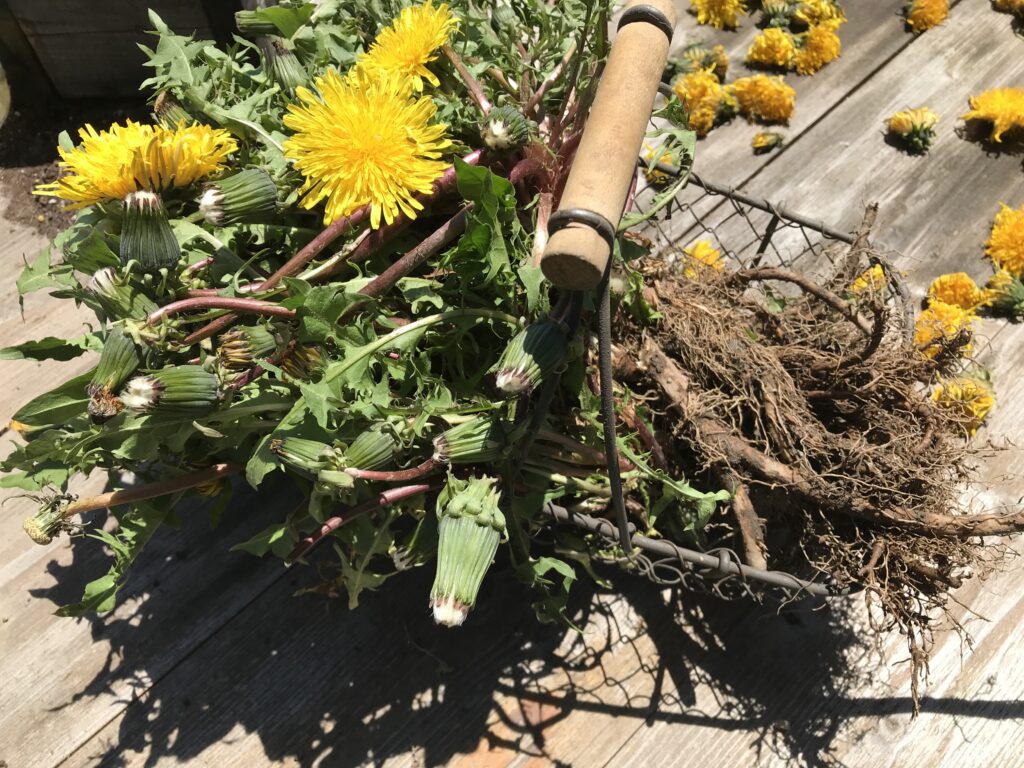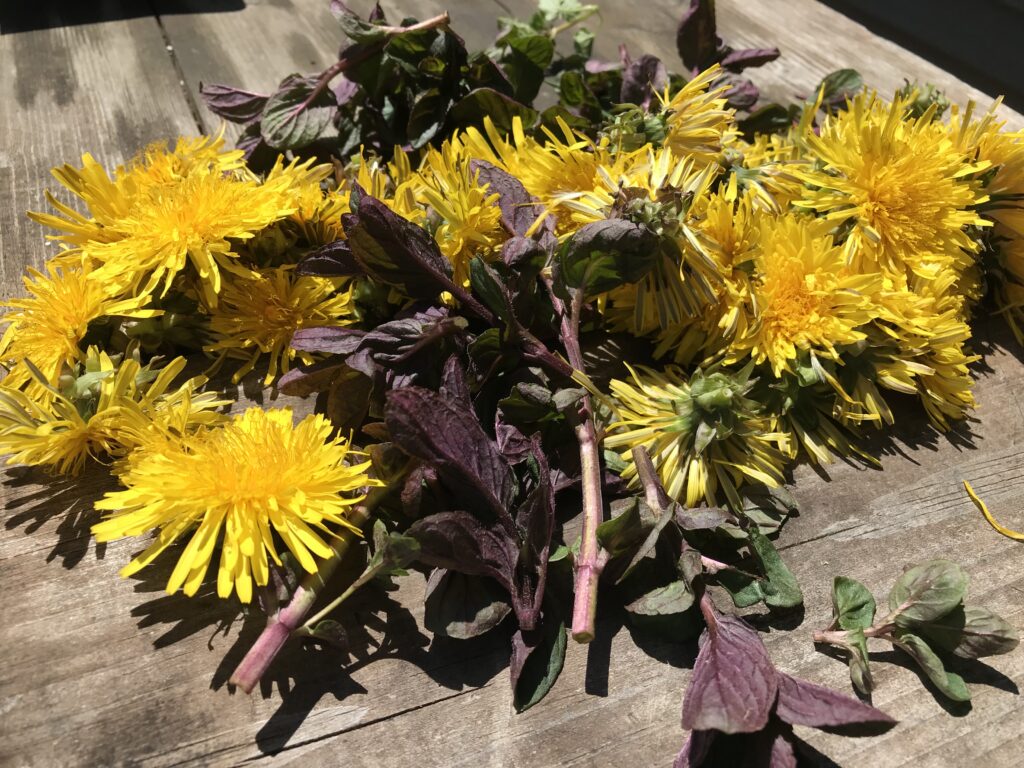To most people dandelions are a common weed and they don’t give them much thought. To others, they are the bane of their existence and there’s little that they wouldn’t do to get rid of them from their yard. I’m here to show you that dandelions are so much more than just a nuisance weed!
Dandelions are a perennial plant that belong to the genus of flowering plants in the family Asteraceae. These pretty little flowers are an important early spring food source for bees and a large number of other pollinators. Not only is the plant good for the bees, the entirety of the plant is edible – from root, to stem, to leaves, to flower. You can consume the whole plant. In fact, dandelions have been used by humans as a food source and herb for much of recorded history.

Dandelions are nutritious and abundant in vitamins and minerals. They are an excellent source of vitamin A, C, and K, and a good source of calcium, potassium, iron, and manganese. They are low in calories and rich in carbohydrates and fiber. Dandelion flowers contain high levels of polyphenols, antioxidants, and have anti-inflammatory, and anti-angiogenic properties.
Throughout history they’ve been used to treat inflammation, swollen lymph nodes, cysts, abscesses, and have been used to help detoxify the kidneys and liver. The health benefits of dandelions are numerous, improving bones health, helping with liver disorders, digestive aid, helping to control diabetes, and they can help prevent urinary tract infections. Dandelions also have numerous skin, blood pressure, and immune benefits. For an in-depth explanation of the health benefits of dandelions check out this article by Meenakshi Nagdeve – 13 Surprising Benefits of Dandelions over at Organic Facts.
Collecting Dandelions
When collecting dandelions make sure you pick them from an area that you know hasn’t been sprayed or treated with any chemicals or pesticides. You want to avoid picking dandelions in high traffic areas, and locations near roads where oil and other pollutants can run off and contaminate the dandelions.
We recommend harvesting dandelion blossoms on a sunny day in the early afternoon after the dew has evaporated off and the flowers are fully open. Use your fingers to gently pop the flower head from the stem. Alternatively, a pair of kitchen shears can be used, however it’s not necessary and using your fingers is quicker. If your recipe calls for just the petals you can remove the green sepals as your picking or after you’ve finished collecting the flower heads.

The leaves are just as easy to harvest, they can be handpicked or cut with a pair of kitchen shears. We recommend harvesting small, young leaves, they will be tender and less bitter.
Dandelion roots take a little more work to harvest, but it’s still a simple and easy process. The roots can be used fresh or dried for later use. Dandelions have deep taproots – they can extend up to 1 foot deep and can be a challenge to get out of the ground. You can harvest the roots at any point in the year. Use a garden fork or shovel to gently loosen the soil and pull out the whole plant. Once you’ve removed the plant, shake off any loose soil, separate the root from the leaves, and continue to clean by rinsing off the roots in the sink. After cleaning you can use the roots fresh or preserve for future use.
Preserving Dandelions for Future Use:
Preserving dandelions for future use is easy and is a great way to tap into the nutritious and healing properties in the fall and winter when fresh plants aren’t available.
Dandelion Flowers – drying flowers for future use is an easy process. Our preferred method is air drying them out in the sun.

- Air drying: Gently scatter and place your dandelion flowers on a smooth flat surface in full sun. Pick a warm and sunny day. After a few hours the flowers will be noticeably wilted. Store loosely in an airtight container.
- Dehydrating: Lay flat in a single layer on a dehydrator try and dry until wilted.

Dandelion Leaves – you can freeze or dehydrate the leaves for future use.
- Freezing: Rinse and trim the leaves. Give the leaves a quick blanch in boiling water for two minutes. Drain the leaves and immediately submerge them into an ice water bath. Pack into freezer containers or use a food saver (our preferred method to freeze and store).
- Dehydrating: Rinse, trim, and pat dry your leaves. Lay flat on a dehydrator tray and dry until crisp. Loosely store in an airtight container.
Dandelion Roots – after you’ve harvested and cleaned your fresh dandelion roots there’s several ways that you preserve your roots.
- Dehydrate: Cut roots into thin strips and place on a dehydrator tray. Continue to dehydrate until the pieces are brittle to the touch
- Hanging: Tie individual roots and hang in a cool, dry location, that has good air flow and circulation. Allow the roots to air dry until brittle. Depending on your conditions this may be a few days up to several weeks. Once dry cut the roots into smaller pieces.
- You can also place the roots on an elevated screen in a cool and dry location that has adequate air flow.
Place your dried roots in a glass jar (we use mason jars) and keep out of direct sunlight.

How are you planning on using your bountiful harvest are you planning on using them fresh or storing for future use?
Until next time…
Ashley


After reading this, I feel like I need to eat several bowls of dandelions each day for optimal health (drizzled with dandelion vinegar!). ✔️✔️✔️
Im going to try this and any other back yard plants for heath.
If I’ve washed and laid them on a towel in the house for two days, do I still have to put them in the sun? I didn’t know to put them in the sun ahead of time, so can I use these or do I toss them and get fresh ones to put in the sun.
Did you mention the dehydrator temperature setting for drying the flowers, leaves, and roots? I did not see it.
I made a Pancake with dandelions and some unsweetened shredded coconut, it was absolutely delicious.
If I get whole dandelion roots up when weeding, I scrub them, snip them into tiny bits with kitchen shears, and dry them. There’s lots of ways to dry herbs: in a loosely folded cotton towel on a sunny window ledge; up on the cupboard tops in a paper bag on it’s side with open ends touching enough to keep dust off but allow a bit of air; in a dish on counter loosely covered with a napkin. Also, after baking something: turn off the oven, the herbs can go in on a tray or dish while it slowly cools down (leave a note to remember they’re in there).
Once “crackly-dry,” the dandelion root bits are stored in a glass jar. I put them in a coffee grinder to make a healthy, tasty coffee substitute (with equal parts roasted chicory, St. John’s Wort, Our Lady’s Thistle, yerba matè, and a bit of cocoa powder; you don’t need all these- even one other herb will do). Steep 5mn with honey (medicinal benefits of thistle are only soluable this way, says St. Bede).
“Therefore give God thanks for His goodness, Who hath given this herb and all others for the benefit of our health.” Mattheolus & Fuschius
What if you harvest a bunch of roots and leave them outside in the sun (no rain) for two weeks accidentally? Would they still be good?